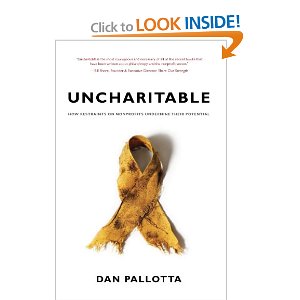 Identifying blog topics can be hard. Sometimes you find a comfort zone and ideas flow freely. Other times, it is next to impossible and the writers block is crippling. So, I love it when readers sometimes email me on the side and suggest topics.
Identifying blog topics can be hard. Sometimes you find a comfort zone and ideas flow freely. Other times, it is next to impossible and the writers block is crippling. So, I love it when readers sometimes email me on the side and suggest topics.
Yesterday, a reader did exactly that when she emailed me with the following request:
“Do you take requests? If so, I would love to hear your take on social service agencies that have more than 6 months of money on hand and the impact of that on fundraising.”
When I first read that email, I planned on squirreling the topic away for one of those days when topic ideas are difficult to come by. However, there was something about this topic that possessed me. I opened up a few Google searches, read a few white papers and blog posts, and found myself whipping out this post.
First, let me start with a very direct response to the question posed by the reader.
I have worked with a disproportionately large number of small non-profit organizations. Organizational capacity for these agencies is always an issue and the amount of cash on hand is typically very small. So, I’ve always advocated to CEOs and their boards that they put plans in place to build operating reserves equal to three to six months.
Only one client to my recollection every worked with more than a six month operating reserve, and I don’t think it impacted their fundraising efforts. If I were to speculate as to why that was, I think the explanation is simple . . . that agency did an excellent job with donor communications and made their case as to why operating reserves of that size were important.
 Setting this one example aside, I do generally believe that building large operating reserves larger than 6 months or one year causes problems with donors. I say this because of everything Dan Pallotta writes in his book Uncharitable and how donors hold the non-profit sector to a different standard than the for-profit sector.
Setting this one example aside, I do generally believe that building large operating reserves larger than 6 months or one year causes problems with donors. I say this because of everything Dan Pallotta writes in his book Uncharitable and how donors hold the non-profit sector to a different standard than the for-profit sector.
In his book, Pallotta talks eloquently about how for-profit corporations are rewarded by investors for generating profits, banking cash and growing organizational capacity. He contrasts this point with how donors punish non-profit organizations for doing the same thing.
For actual examples and a better explanation, I encourage you to read his book. I promise that it will be an eye opening experience. Additionally, you’ll likely walk away from the exercise and find yourself muttering the words: “Damn Puritans!”
In my clicking around and Googling, I found a number of interesting facts including:
- Charity Navigator reserves its top ratings for organizations with 12 or more months of working capital.
- The Nonprofit Finance Fund reported in its 2012 State of the Sector Survey that only one-fifth of survey respondents said they felt their donors were comfortable talking about operating reserves.
- In 2011, more than three-quarters of non-profit organizations had less than 4 months of expenses in operating reserves (60% reported less than 4 months and 28% reported one month or less).
I strongly urge you to click-through and read more startling statistics on this and similar subjects at:
- Executive Service Corp, “How Much in Reserve Funds Should Your Nonprofit Have?“
- Nonprofit Finance Fund, “2012 State of the Sector Survey“
- Nell Edgington’s Social Velocity blog, “A Financial Taboo Nonprofits Must Get Over“
I want to thank the reader who suggested this blog topic because they have caused me to change my thinking on this topic. From now on, when agencies ask my advice on what they should strive towards with regards to building an operating reserve, I plan on telling them . . .
12 months or more! ! ! !
With this Big Harry Audacious Goal (BHAG), the next words out of my mouth will be . . .
“Create a strong case for support or prepare to incur the wrath of donors.”
For those of you who don’t think this is possible, please take a moment to think about why that much cash on hand is important to your organization.
- Many agencies are using their operating reserves as cash flow cushions as they wait for their accounts receivable from government grants. (Believe it or not some states are six to 12 months late in paying their bills.)
- It is a sign of financial health to have operating reserves of this size.
- One of the lessons learned from the recent economic recession is that larger rainy day funds are a necessity and not a luxury.
- Stuff breaks and your organization needs to be in a position to fix the roof or replace a HVAC unit without running off to donors with an urgent case for support that sounds like a crisis or fire drill.
My advice to anyone who cares to hear it is:
- Set a goal to increase your operating reserves to 12+ months
- Work with the Finance Committee to develop a plan to achieve this goal (Yes, it will likely be a plan that spans many years). Perhaps, include in your plans to use a portion of your operating reserves to invest in organizational capacity building once certain targets are achieved.
- Work with the Resource Development Committee to write a case for support that supports these actions.
- Don’t hide from donors. Get out there and start talking to them. Weave the talking points from this new case for support focused on increasing reserve levels into your stewardship efforts. Donor engagement and education is the key to success.
So, I’m curious how many of you think I’m crazy? How big are your reserves? How big would you like them? What do your donors say about your reserves? Please use the comment box below to weigh-in on this discussion.
Here’s to your health!
Erik Anderson
Founder & President, The Healthy Non-Profit LLC
www.thehealthynonprofit.com
erik@thehealthynonprofit.com
http://twitter.com/#!/eanderson847
http://www.facebook.com/eanderson847
http://www.linkedin.com/in/erikanderson847
